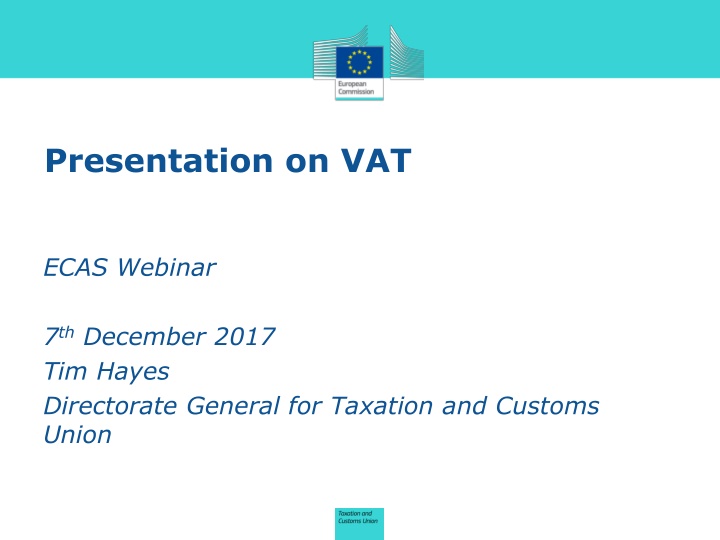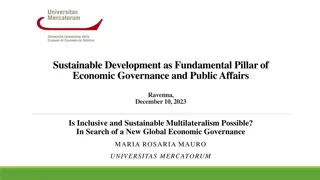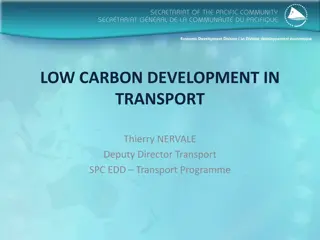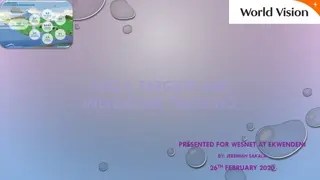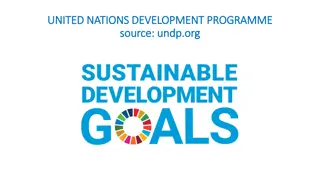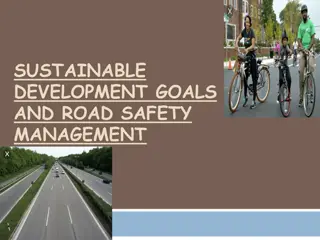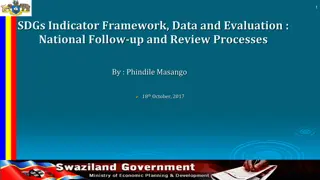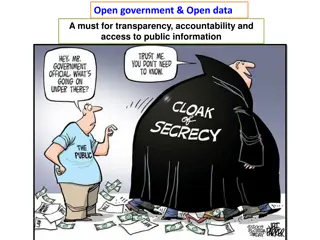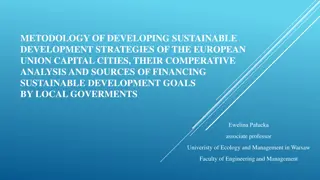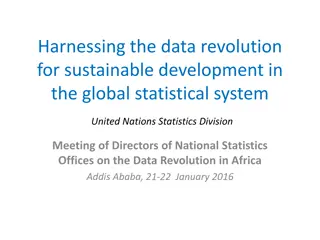Data Perspectives on Sustainable Development Goals
The presentation delves into the crucial role of statisticians and policy-makers in shaping the post-2015 agenda for sustainable development. It emphasizes the need for constructive collaboration to ensure quality, integrity, and universal measurement. Various aspects such as choosing SMART indicators, importance of datasets and standards, and the state of statistics are discussed in detail, shedding light on the challenges and opportunities ahead.
Download Presentation

Please find below an Image/Link to download the presentation.
The content on the website is provided AS IS for your information and personal use only. It may not be sold, licensed, or shared on other websites without obtaining consent from the author.If you encounter any issues during the download, it is possible that the publisher has removed the file from their server.
You are allowed to download the files provided on this website for personal or commercial use, subject to the condition that they are used lawfully. All files are the property of their respective owners.
The content on the website is provided AS IS for your information and personal use only. It may not be sold, licensed, or shared on other websites without obtaining consent from the author.
E N D
Presentation Transcript
Presentation on VAT ECAS Webinar 7thDecember 2017 Tim Hayes Directorate General for Taxation and Customs Union
Structure of the presentation how Basic principles of VAT - the what; why; when; who and Place of supply rules Deduction Exemption Rates Special schemes Taxation of motor vehicles Internet purchases 2
Legal base for proposals Treaty on the Functioning of the European Union. Legal base for legislative proposals is Article 113 of the a special legislative procedure and after consulting the European Parliament and the Economic and Social Committee, adopt provisions for the harmonisation of legislation concerning turnover taxes, excise duties and other forms of indirect taxation to the extent that such harmonisation is necessary to ensure the establishment and the functioning of the internal market and to avoid distortion of competition. The need for unanimity in matters relating to indirect taxation generally means that Community legislation is by means of Directives, not Regulations. The Council shall, acting unanimously in accordance with 3
What the Courts say about VAT tax (VAT), a kind of fiscal theme park in which factual and legal realities are suspended or inverted." "VAT is a "complex parallel universe" in which "relatively uncomplicated solutions" are a snare and a delusion" "Special difficulties arise, in the mystic twilight of VAT legislation " "Beyond the everyday world lies the world of value added 4
The advantages of VAT Cheap to collect Efficient More than 1 trillion ( 1,035.3 billion in 2015) VAT "Gap" 152 billion Fully integrated into normal business practices Understood/tolerated by the public Almost 30 million taxable persons About 50,000 big businesses 80/20 rule
What? taxable goods and services. Each trader pays VAT on goods and services purchased for the business and charges VAT on goods and services supplied by the business. The difference between the VAT charged by and the VAT charged to must be paid to the Treasury. If the amount of VAT paid exceeds the VAT charged, the Treasury will (generally) repay the excess. VAT is paid by the ultimate customer, not by the business. A consumer/turnover/value added tax. Collected by VAT registered traders on their supplies of 6
Why? 1968: VAT introduced - replacement of national cascade-type taxes Part of the Acquis Communautaire 1977: 6th VAT Directive - further harmonisation of VAT as VAT becomes an OWN RESOURCE of the EU 1993: Internal market - abolition of fiscal frontiers, transitional VAT system 7
When? The supplies of goods and services for consideration within the territory of the country by a taxable person acting as such Importation of goods 8
Who? any economic activity, whatever its purpose or result. Excludes employed persons Grouping of taxable persons Public authorities - Are not taxable persons if acting as such Exception: when distortion of competition Engaged in activities listed in Annex I TAXABLE PERSON Is any person who independently carries out in any place 9
How? consumption is deemed to take place Allocate tax receipts to the Member State where the For goods: where the goods are when supplied or when transport begins - Exception: - installation - means of transport 10
How? - services at the customer's place of establishment Supplied to private individuals (B2C services) are taxed at the supplier's place of establishment. Particular provisions - immovable property - Transport services - Restaurant services - Cultural and artistic services - Digital services Between businesses (B2B services) is in principle taxed 11
Import/Export Aim: equal treatment of imported goods and goods supplied within a Member State Taxation of imports Exemption of supplies for export 12
THE RIGHT TO DEDUCT business expense No deduction for non-business expenditure Special arrangements for taxable persons not established in the Member State where VAT was paid * 8th directive (taxable persons of other Member State) * 13th directive (taxable persons of third countries) VAT on purchases by taxable persons is deductible if 13
VAT EXEMPTION Mechanism No VAT on outputs of exempt taxable persons No deduction of VAT on their purchases Types of exemption For certain activities in public interest (medical, educational, social, sector) Other exemptions - Banking and insurance - Leasing and letting of immovable property 14
Exemptions on importation Travellers' allowances (Directive 69/169/EEC) re-importation diplomatic arrangements 15
RATES 5% to certain goods/services A number of temporary derogations, e.g. 0% rates in the UK and Ireland New Member States Standard rate of not less than 15% Member States may apply 1 or 2 reduced rates of at least 16
SPECIAL SCHEMES Small businesses (turnover less than (See our VAT Thresholds document) Exemption Simplification Graduated relief Flat-rate scheme for farmers Travel agents Margin scheme for second-hand goods, collector s items and works of art Exemption for investment gold Telecom, broadcasting and e-services supplied by non- established operators 17
Obligations on taxable persons Registration VAT identification number Accounts Issue of invoices VAT declarations Payment of amounts due 18
THE CURRENT VAT SYSTEM (1993-) movement of goods and persons between Member States. Basic principles * Private persons and other end-users: taxation in Member State of purchase (AT ORIGIN) * IMPORT/EXPORT between Member States replaced by intra-Community supply and acquisition (taxation AT DESTINATION) * New obligations replace border controls (VIES) Abolition of fiscal controls was essential to enable free 19
TRANSITIONAL VAT SYSTEM - SPECIAL SCHEMES AIM: PRESERVE MEMBER STATES VAT RECEIPTS New means of transport : VAT of Member State of destination Distance selling : VAT of Member State of destination if sales in that Member State exceed a certain threshold Supplies to non-taxable persons and exempt taxable persons : VAT in Member State of destination if purchases exceed a certain threshold 20
WEAKNESSES OF THE PRESENT VAT SYSTEM Complexity Maintains distinction internal intra-EC supplies Taxable persons have obligations in each Member State where transactions are carried out Many special schemes and derogations High cost for doing cross-border business 11% higher than just doing business in "home" Member State 21
WEAKNESSES OF THE PRESENT VAT SYSTEM Difficult to control - Open to fraud and evasion VAT Gap study shows 152 billion in 2015 of which 24% is estimated to be "missing trader" fraud No uniform application Outdated VAT action Plan of 7th April 2016 (COM(2016) 148 final) 22
Motor vehicles when and where to register "Your Europe" You always have to register your car in your country of residence and pay any associated registration and road taxes, regardless of whether you pay VAT or not. Unawareness of vehicle VAT rules among car dealerships (Your Europe Advice report 3Q2017) Rules have not changed since 1993
VAT on motor vehicles bought by private persons 1. New vehicle purchased in own Member State 2. New vehicle purchased in a Member State other than own 3. Second-hand vehicle purchased in own Member State 4. Second-Hand vehicle purchased in a Member State other than own 5. Move from one Member State to another
New vehicle purchased in own Member State Pay VAT to the dealer included in the price. Registration tax may be included or may have to be paid separately VAT may be deductible by taxable person
New vehicle purchased in a Member State other than own No VAT payable to the dealer (Article 138(2)(a) of the VAT Directive) Dealer may require proof of residence or may request a deposit equivalent to the VAT to be refunded on proof of payment in "home" Member State VAT payable to administration (Article 2(1)(b)(ii) of the VAT Directive) home tax/registration
What is a new vehicle for VAT purposes? The vehicle is supplied within 6 months of the date of first entry into service Or The vehicle has travelled for no more than 6000 km at the time of the supply. Article 2(2)(b)(i) of the VAT Directive But, a five year old vehicle which has only travelled 4,000 km is still a "new vehicle" and a 3 month old vehicle which has travelled 40,000 km is also still new for VAT purposes.
Purchase a new vehicle from a non-taxable person in another Member State buyer (when he is a non taxable person) who resells the car when the car is still a new car. The initial buyer becomes a taxable person for this supply and is able to get a part refund of VAT paid on the initial transaction to avoid double taxation on the same car (Art. 9(2) and 172 of the VAT Directive). Special rules exist when the car was bought by the initial
Second-hand vehicle purchased in own Member State - The car is supplied more than 6 months after the date of first entry into service And - The car has travelled more than 6,000 km at the time of the supply. The normal rules are applicable - Tax is payable if purchased from a dealer; no VAT if purchased from a private individual (outside the scope of VAT)
Purchase of a second-hand vehicle from a dealer Two kinds of second-hand cars for VAT purposes : The previous owner was a taxable person and has deducted input VAT on the initial price of the car: full price subject to VAT The previous owner did not get any deduction for VAT on the car (individual, exclusion of right of deduction): the special "margin scheme" is applicable
What is the "margin scheme"? Purpose is to avoid double taxation on the vehicle Tax is paid by the taxable dealer. Tax base: profit margin made by the taxable dealer less the amount of VAT relating to the profit margin.
What happens on moving from one Member State to another with a vehicle? Since 1993, moving from one Member State to another is no longer a taxable event for VAT purposes. No taxation occurs if there is no supply with transfer of ownership. Moving is still a taxable event when you move from a non-EU country to a Member State: VAT on importation has to be paid. Registration obligations (See Your Europe)
Elephant traps - Take care: there is a restriction when you buy a "new car" just before moving from one Member State to another. - The place of acquisition can be, on a case by case basis, the Member State the buyer is moving to, in particular : if, at that time, the buyer has already taken the decision to move (just before retiring for example) and the acquisition takes place just before moving, the car has never been registered in the Member State the buyer is moving from.
Internet sales - Distance selling rules - Sales of goods - Digital services
Distance selling - goods State of destination 35,000/ 100,000 depending on the Member State (see the "VAT thresholds" document on our website) Under threshold, conditions of Member State of establishment Over threshold, conditions of Member State of customer Taxable person may also opt to register, even if under the threshold One of the 3 "special schemes" introduced in 1993 Place of taxation depends on the turnover in the Member
Digital services B2B: Reverse charge B2C: Taxable in the Member State of the customer One Stop Shop to discharge reporting and payment obligations No registration threshold for electronically supplied services to customers in another Member State
What are "digital services"? Broadcasting services Telecommunications services Electronic services delivered over the Internet or an electronic network supply essentially automated involving minimal human intervention impossible to ensure in the absence of information technology
How long have the rules been in place? Member State of establishment Digital services supplied by non-established taxable persons: 1st July 2003 (one-stop shop) B2B Digital services taxed in Member State of Customer since 1st January 2010 B2C Digital services supplied by established taxable persons: Taxable in the Member State of the customer since 1st January 2015 Goods: 1993 Services: Until 30th June 2002 All digital services taxed in
Questions? 39
